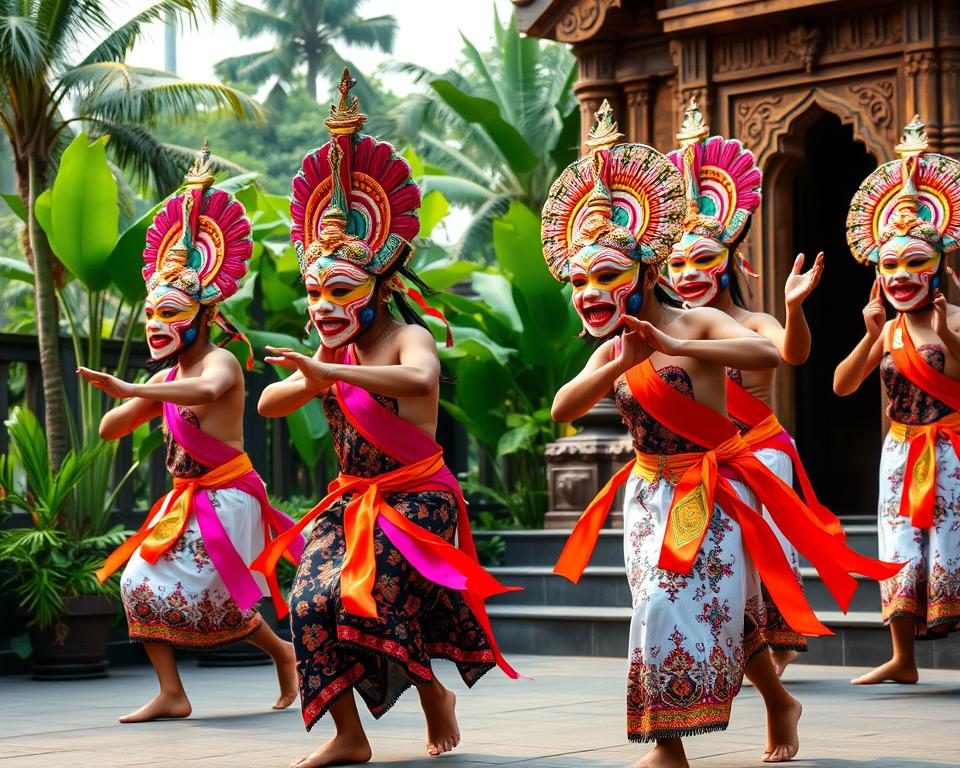
Discover Bali’s Enchanting Topeng Dance Tradition
Picture yourself on a tropical island, surrounded by amazing views and ancient stories in the air. The sounds of the gamelan draw you closer to a world where Topeng dance comes alive. This performance is more than just a show; it’s a journey into Balinese mask dance. Every move tells a story of culture and spirituality. Watching the dancers, you’re drawn into a tapestry of tradition that bridges the past and present. It connects us all through its beauty and emotions.
The roots of Balinese mask dances go back to A.D. 896, showing its long history1. A Topeng dance can last four hours, taking you through timeless stories1. In Ubud, creativity shines, with works from both traditional and modern artists. This place keeps the dance culture alive1. Nearby, the Setia Darma House of Masks and Puppets showcases over 1,300 masks and 5,700 puppets1. The skilled artisans of Mas village pass their carving talents through generations. This keeps the mask dance tradition strong1.
Key Takeaways
- The Topeng dance is a vital part of Balinese culture, originating from historical practices dating back centuries.
- A typical performance can last around four hours, showcasing an elaborate storytelling tradition.
- Ubud is recognised as Bali’s cultural epicentre, rich with artistic expression and traditional crafts.
- Topeng dance performances are enhanced by the use of intricate masks that symbolize various characters.
- The dance not only entertains but serves as a medium for cultural education and spiritual connection.
The Rich History of Balinese Dance
In Bali, dance tells the history of the island. It mixes tradition and creativity, showing tales of gods, spirits, and life. The arrival of Hinduism changed Bali’s culture, making its art thrive. After the Majapahit Kingdom’s decline, artists brought their skills to Bali. They mixed local and Javanese traditions, making dance a key part of Bali’s heritage.
Influence of Hinduism and Javanese Ruins
Hinduism’s arrival in Bali brought new depth to its performances. Balinese shows mix rituals and stories with divine beings. Influences from Javanese ruins can be seen, sharing stories of wars, creation, and moral battles. Each dance has a unique story but shares Hindu values of life, spirituality, and togetherness.
The Evolution of Dance from Rituals to Performance
Over time, Balinese dances evolved from temple rituals to public shows. What once was for gods and harvests became entertainment. Theatre elements were added, winning over locals and tourists. These performances teach lessons and reflect Hindu beliefs still important in Bali. They show the culture and spirit of the Balinese.
If you want to see this art up close, watch a performance. These dances share stories vital to Bali’s culture. Take time to see how these performances capture the island’s spirit234.
Understanding the Topeng Dance Tradition
Topeng dance is rich in culture and tells meaningful stories through its art. “Topeng” means “mask,” showing us a deep link to identity and change. Each mask tells a story. It shows unique characters and stories, revealing its importance in Balinese culture. It’s done to honor ancestors and share ancient stories of leadership, love, and wisdom. To learn more, check out the significance of Topeng.
Definition and Significance of Topeng Dance
Topeng dance mixes stories and beautiful Balinese traditions. It started in Indonesia but now reaches many5. There are different kinds like Topeng Pajegan and Topeng Panca, offering diverse experiences5. This dance connects people today with old heroes and myths. The masks, made of wood or fabric, show gods, animals, and legends. They represent spirits of kings and heroes5.
Transformation Through the Mask: The Role of Tapel
The mask, or tapel, is key in Topeng dance. It helps the dancer connect deeply with their character. This makes the performance more than just acting. It’s a real bond between the dancer and the story. Dancers practice a lot and follow rituals to truly become one with the mask6.
The dance is lively, with dancers and musicians working together. They perform at ceremonies like Ngawit and Odalan. This keeps Bali’s traditions alive6.
The Cultural Context of Topeng Dance
Dive into the colourful world of Topeng dance to find a mix of tradition, spirituality, and community. In Bali’s cultural core, during temple festivals, this art shines. The performances link the community with their gods and ancestors.
Topeng Dance in Temple Festivals
During temple festivals lasting 3-11 days, Topeng dances highlight community and devotion7. These events, called “odalan,” show the dance’s deep Balinese roots. Masks in the dance portray deities, expressing character vividly. An actor might use up to 40 unique masks, showing the dance’s significance and variety in temples8.
Topeng Performances During Family Rituals
In family rituals, Topeng celebrates personal expression and heritage. Performers revive old tales and humor, from holy texts to satire7. They often improvise, changing with the audience’s mood and music7. These acts strengthen family ties and showcase individual stories, like “The Adventures of Prince Panji”8.
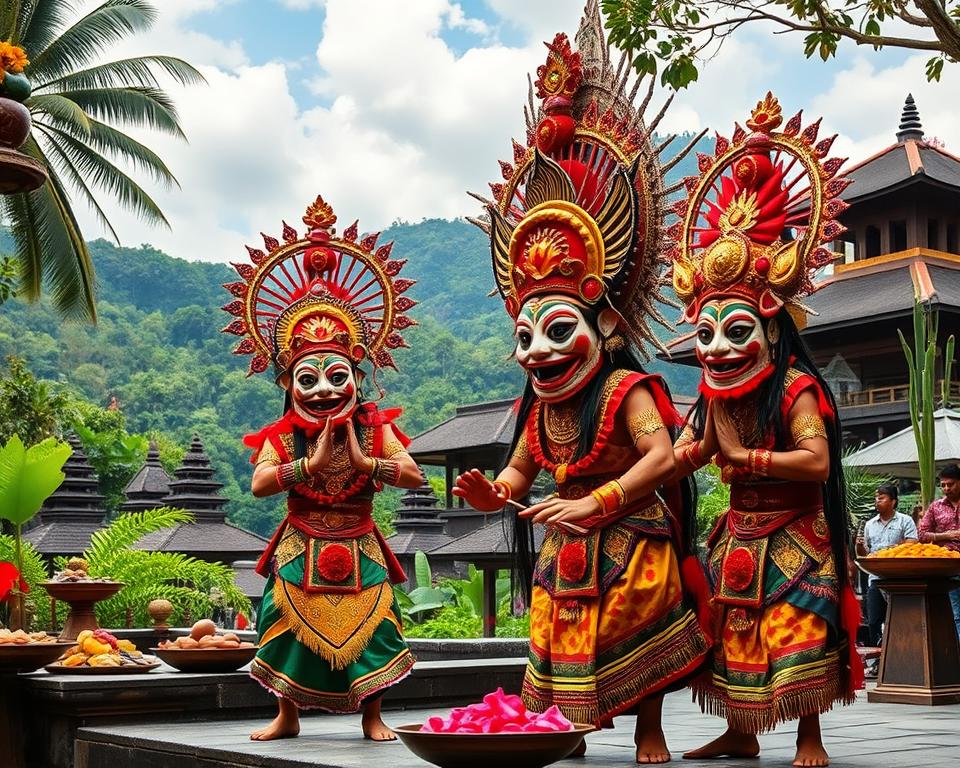
Types of Topeng Dance Forms
The Topeng dance takes us on an amazing journey through vibrant expressions. Each has its tale. The Topeng Pajegan and Topeng Panca are truly standout performances. They grab everyone’s attention with stories and skilled dance moves. Every mask and move tells a part of Bali’s deep culture.
Topeng Pajegan vs. Topeng Panca
Topeng Pajegan is known for its heart-touching stories. It mixes drama and feeling in a unique way. These performances also bring folklore to life, making the audience feel deep emotions. On the other hand, Topeng Panca is more about fun. It shows characters like kings and clowns in a comedic style. Each dance is a colourful peek into the heart of Bali.
Character-Driven Storytelling in Dance
Dancers in Topeng become different characters through their storytelling. They often take inspiration from the Mahabharata and Ramayana. This way, they share myths and cultural values. Masks are key, with colours showing character traits. White or golden masks signify noble qualities, and red might show strength.
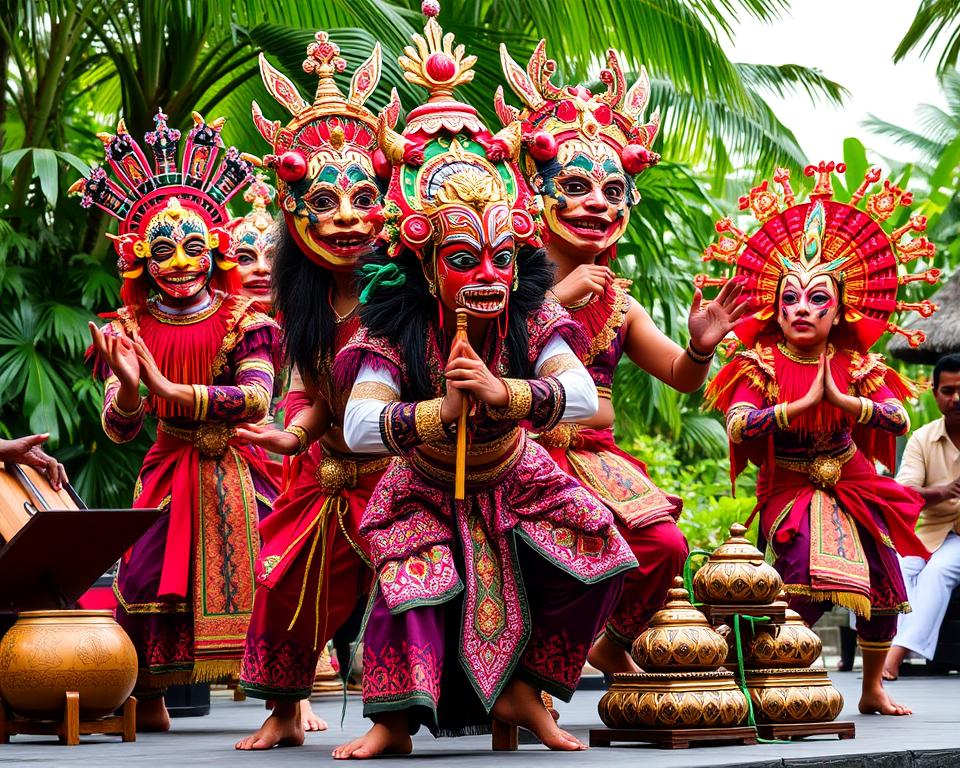
Looking into Topeng dance, you learn about Bali’s traditions and spiritual life. The masked dancers pull you into their world of history and drama. To dive deeper into Bali’s culture, check out the ceremonies at the Ubud Monkey Forest. It’s a place full of respect and cultural expression910.
Components of Topeng Dance Performances
The beauty of Topeng dance lies in its rich elements. It combines gamelan music and the art of costumes and masks. This blend of culture grabs the attention of those who watch. It also shares the deep spirit of Balinese tradition.
The Integral Role of Gamelan Music
Gamelan music is key to Topeng dance, offering captivating rhythms. Musicians play instruments like gongs and drums with skill. This creates sound that leads dancers and delights the audience.
Everyone meets in outdoor temple courtyards for the show. The mood is buzzing, as people can’t wait to see the performance. The sound of gongs and cymbals fills the night11.
Costumes and Masks: The Art of Creation
Costumes and masks are just as important, made with care and creativity. They are more than just clothes; they represent characters and beliefs. Masks, carved from the sacred pule tree, are honored greatly. This careful work makes each mask a key part of Topeng12 and13.
With every move, stories jump to life. Valor, humor, and love stories are told. Costumes and masks work together to make the story stronger11.
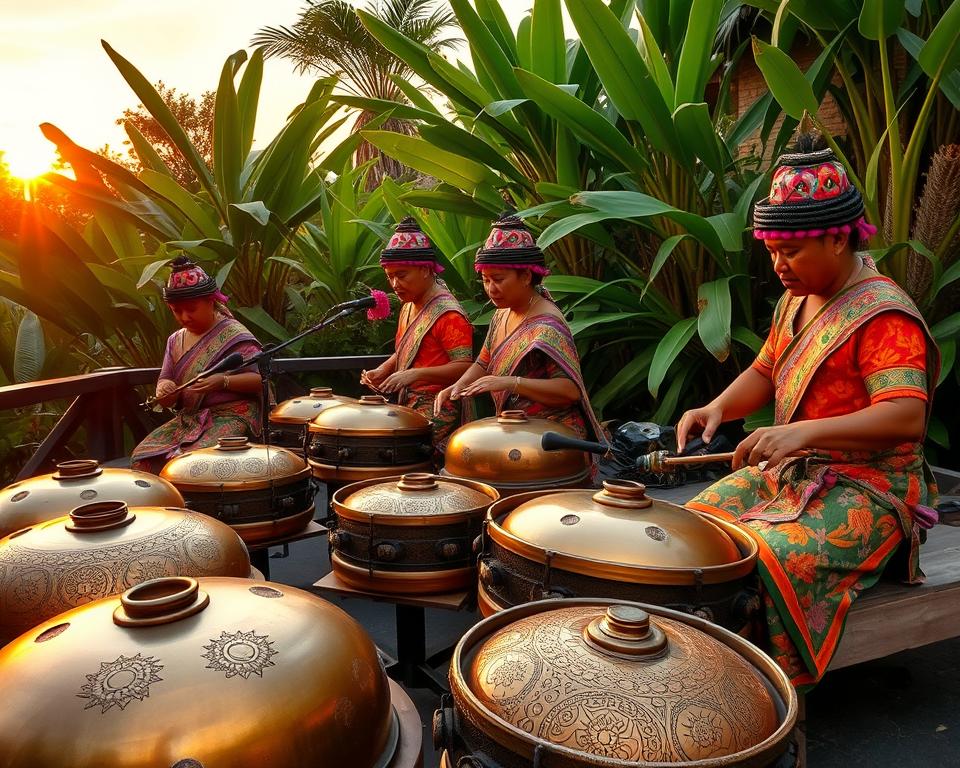
The Artistic Freedom in Topeng Dance
When you explore Topeng dance, you find its soul in artistic freedom. Dancers become storytellers, bringing old tales to life. Their use of improvisation enchants viewers as each show has its special beat, showcasing spontaneous creativity.
Improvisation: The Dance’s Dynamic Nature
Improvisation is where Topeng dance truly shines. Artists draw from the audience’s energy, shaping their movements and the story’s course. This liberty allows for a personal touch within set traditions, offering fresh experiences with every show. Dancers’ creative freedom turns a routine act into a live, dynamic expression, creating a cultural conversation.
Balance Between Traditional Structure and Creative Expression
Topeng dance skillfully blends tradition and creativity. It follows certain rules, but dancers add their spin, showcasing a diverse cultural story. This mix of heritage and personal creativity bridges the old and the new. It celebrates both the tradition and the dancer’s inventiveness. This evolving balance shows the dance’s versatility and deepens the bond between performers and viewers.
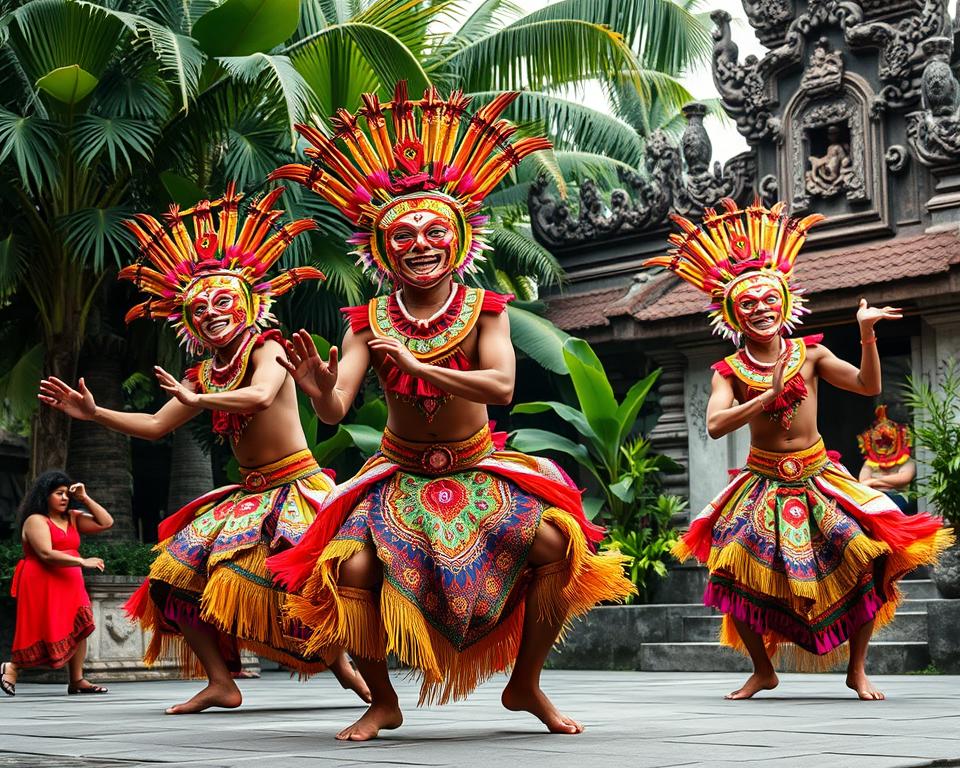
Experiencing Topeng dance, you feel a connection between history, creativity, and cultural talk. It highlights the artistic freedom, the magic of improvisation, and the balance between tradition and creativity. This freedom links you deeply to Bali’s unique stories.
Discover more about this tradition and its surrounding practices. Visit the Sacred Monkey Forest. Here, spirituality, culture, and nature blend beautifully. Each Topeng dance show will deepen your insight into its delicate balance.
This lively art is part of Indonesia’s broad cultural landscape. It has expression that echoes across ages1415.
Topeng Dance and Spiritual Connection
Enter the world of Topeng dance and feel a deep spiritual connection. It’s like a bridge to the cosmos, making dancers mediums for divine forces. Through this dance, the heart of Balinese culture comes alive, engaging your senses fully.
Connecting with Deities through Dance
Dancers in Topeng form a deep link with gods, sharing ancient wisdom and respect. Their movements are a sacred chat, reaching beyond our world. Around 30 locals watch from their compounds, with 80 more outside, making the ceremony vibrant16. The dance happens in a special 4 x 6 feet area, telling godly tales.
The Ritual Significance of Masks
Masks in Topeng dance are more than just props; they’re full of spirit and story. These masks let dancers bring forth ancient energies and tales. The tradition, alive since the 15th century, shows masks’ power in spiritual connections17. In some dances, performers switch between five masks, each with its own story and blessing.
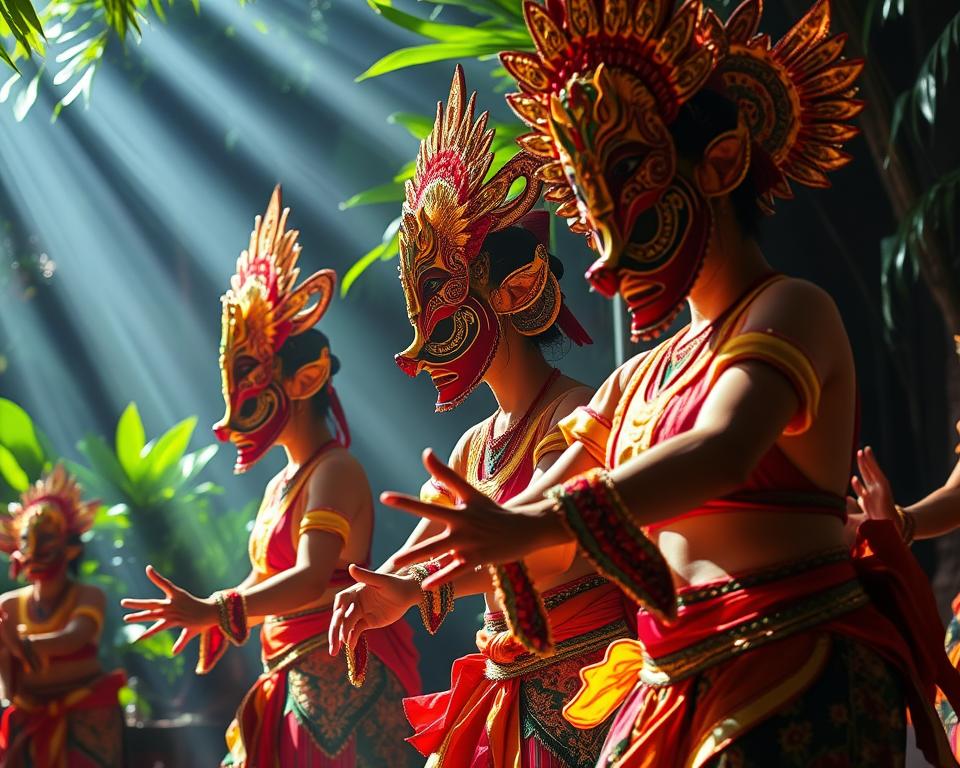
This magical tradition shows Bali’s sacred arts vividly. It’s a deep dive into spiritual connection shown through dedication. The wait for rituals, often 4.5 hours long, builds a palpable excitement in the air.
Iconic Characters in Topeng Dance
In the Topeng dance’s colourful world, iconic characters stand out. Prince Panji, the noble figure, showcases courage and honour. You connect with long-standing themes of heroism through his portrayal.
Heroic Figures: Prince Panji
Prince Panji is not just a hero in these stories. His adventures are about love, sacrifice, and victory. As you watch, you see how fate and choice mix, showing values important to society. Topeng dance shares these stories, letting us think about our lives and heroes.
Comic Characters and Their Role in Narration
The comic figures bring laughs, balancing the deep stories of heroes like Prince Panji. They talk to you directly, making things more fun. By making jokes, they explain big ideas in an easy way. So, they are key to telling the story, keeping it interesting and meaningful.
Heroic tales and funny moments mix to make a story full of feelings and ideas. Watching, you see each character shares our group memories. They help keep our culture alive through their stories, touching everyone. Stories, sad or funny, speak to us all, sharing Bali’s unique culture.
Want to know more about Topeng dance and its characters? Check out the Topeng dance tradition. Discover the characters and their stories that keep charming viewers18.
Where to Experience Topeng Dance in Bali
If you want to dive into the world of Topeng dance, Bali is the place. Here, many venues show the beauty of this dance. Each location brings to life stories told through masks and movement.
Top Venues for Authentic Performances
- Ubud Palace: A grand place where dancers with great skill amaze you, giving a memory of Topeng dance to hold onto.
- Setia Darma House of Masks and Puppets: It’s full of masks, essential for seeing Topeng dance in its pure form.
- ARMA Museum & Resort: Nightly dances offer a glimpse into Bali’s art10, touching the heart.
- Lotus Cafe: In Ubud, this spot has dance shows that fill the air with magic, near Taman Saraswati Temple.
- Sahadewa Barong at Batubulan: Since 1972, this place offers Balinese dance, a true taste of history19.
- Leke Leke Garden Restaurant: Have dinner and enjoy traditional dance shows. It mixes great food with culture.
- Surya Mandala Cultural Park: By Tanah Lot Temple, see the breathtaking Kecak dance at sunset19.
Balinese Festivals featuring Topeng Dance
Bali’s festivals celebrate Topeng dance, showing its role in the community. The Bali Arts Festival showcases this dance. It combines old tradition and new style. Visitors get to see dances, try local food, and learn customs. Interesting festivals reveal Bali’s rich culture. The Old Man Mask Dance is a special dance seen at religious events or for fun today20.
The Community of Dancers and Mask Makers
The Topeng dance of Bali lives on through a special group of dancers and makers. This group not only brings the dance’s rich history to life but also ties closely with the Mas village artisans. These mask makers are famous for their outstanding work.
Meet the Artisans: Mask Makers of Mas Village
In Mas Village, every mask is a piece of history and a display of skill. The artisans put their hearts into their work. They make sure each mask shows the character’s cultural background and Balinese tradition spirit. Sadly, fewer people now know the traditional ways of making masks. Statistics show only about 30 artisans are left, a big drop from when 80% of the villagers were wood artisans21. These skilled workers create art and keep their culture alive, making an indelible mark on the mask-making community.
Generational Transmission of Dance and Craft
The passing of dance and craft skills is key to keeping Balinese arts alive. Young people get intense training in traditional dances, learning to bring characters to life. One such dance is Topeng Tua, standing for wisdom and age22. This skill sharing is crucial. It helps keep the dance vibrant as older artists teach the young. This way, the community of dancers grows strong, honoring their roots while diving deep into their artistic heritage.
Comparing Topeng Dance with Other Balinese Dances
Comparing Topeng dance with other Balinese dances like Legong and Kecak shows a world of art. Each dance expresses its unique cultural value and characteristics. This invites us into the heart of Bali’s performing world.
Topeng vs. Legong and Kecak Dances
Topeng dance is different from the graceful Legong dance. Legong is known for its delicate beauty and detailed movements. Unlike Legong, Topeng uses masks to tell stories through various characters. On the other hand, Kecak dance includes lively chanting and a group performance, offering a distinct theatrical vibe.
These differences showcase each dance’s special qualities. They also show the wide range of Balinese dance enjoyed by locals and tourists. Exploring these dances reveals centuries-old traditions that capture the soul of Bali.
The Diverse Styles of Balinese Dance Culture
In Bali, dance styles range from sacred to entertainment. Sacred dances have been performed in temples since the 8th-14th centuries. Semi-sacred dances mix storytelling with rituals, sharing important cultural tales. Entertainment dances mix old myths with new themes, creating a fresh view of tradition.
This dive into Balinese dance uncovers a deep cultural treasure. It links past to present, celebrating stories through dance. Each performance is a festive blend of history and artistry, showcasing Bali’s rich dance culture.
Conclusion
The Topeng dance is a key part of Bali’s cultural story. It brings together history, spirituality, and art. Each dance tells a story that connects us to Balinese heritage. These stories celebrate life’s sacred and joyful moments. They show the heart of Bali’s traditions, handed down through the years.
In the Topeng dance, performers wear masks and dance to music, bringing tales to life. This isn’t just a show; it’s a deep dive into a living tradition that connects the spiritual with the everyday. To learn more about Topeng dance, its role in festivals and its impact on the community, check out articles like this one here23.
Seeing the Topeng dance makes you think about your own path in life. The characters in the dance act as guides and teachers. They show us how everything in life is connected. When you visit Bali, you find adventures waiting, like meeting the playful monkeys at the Ubud Monkey Forest. This is part of discovering Bali’s vibrant spirit24. Take this spirit home with you, a precious part of Bali’s artistic legacy.
FAQ
What is Topeng Dance?
Topeng Dance is a traditional dance from Bali. It uses masks to tell stories. These stories are from Bali’s culture.
What is the significance of the masks in Topeng Dance?
“Topeng” means “mask” in Balinese. Each mask has its own character. They connect the dancer to the dance spiritually.
How does Topeng Dance evolve from rituals to performance art?
It started in religious rituals. Now, it’s a cultural dance show. But, it still has its spiritual meaning.
Can you describe the different forms of Topeng Dance?
Topeng Pajegan tells sad stories. Topeng Panca is funny. Both show different styles and character portrayals.
What role does gamelan music play in the Topeng Dance?
Gamelan music gives rhythm to the dance. It helps make the performance beautiful. It guides the dancers too.
What is the importance of improvisation in the Topeng Dance tradition?
Improvisation lets dancers be creative. They mix tradition with their own style. This makes the performance fresh and exciting.
How does the Topeng Dance connect to spirituality?
It connects dancers to gods. The masks have spirits. This spiritual link is key in Balinese culture.
Who are some iconic characters in Topeng Dance?
Prince Panji is a hero with high morals. There are funny characters too. They reflect Balinese society and values.
Where can I experience authentic Topeng Dance performances in Bali?
Check out Ubud Palace or the Bali Arts Festival. They show the real Topeng Dance of Bali.
How is the tradition of mask-making preserved in Bali?
In Mas Village, artisans teach the young ones. This keeps the mask-making and dance traditions alive.
How does Topeng Dance compare to other Balinese dances like Legong and Kecak?
Topeng allows for free storytelling. Legong is about grace. Kecak uses powerful chanting. Each dance is unique in Bali.
Q: What is the significance of mask dance in Balinese culture?
A: The mask dance, or tari topeng, holds great cultural significance as it is a form of dance drama that allows performers to embody different characters, often drawing from Indonesian mythology and history. The use of masks in these performances symbolizes the transformation of the dancers into the characters they portray, showcasing their cultural heritage and artistic expression.
Q: How do the dance masks contribute to the storytelling in topeng performances?
A: The dance masks, or topeng masks, are crucial in conveying the characters’ emotions and identities. They often depict exaggerated features that can reflect the personalities of the characters, enhancing the storytelling aspect of the performance. This use of masks allows the audience to connect with the narrative on a deeper level, as the masked characters may embody historical figures or mythological beings.
Q: Can you explain the relationship between topeng dance and Hinduism in Indonesia?
A: Topeng dance is deeply intertwined with Hinduism in Indonesia, often depicting stories and characters from Hindu epics such as the Ramayana. This integration of religion into the performances highlights the cultural heritage of the region and the role of dance as a means of interpreting religious narratives, especially through the portrayal of gods and mythological figures.
Q: What are some notable historical influences on the topeng dance tradition?
A: The topeng dance tradition has been influenced by various historical kingdoms, such as the Kediri Kingdom and the Mataram Sultanate, as well as the Chandra dynasty. These influences are evident in the themes, characters, and styles of the performances, as they often reflect the socio-political context of the time, including the impact of the Cirebonese people and the Javanese culture.
Q: What character types are commonly found in topeng performances?
A: Topeng performances feature a variety of masked characters, including heroic figures, comedic characters, and even caricatures of social types. Characters like Barong, who symbolizes good, and Rangda, who embodies evil, are central to many narratives, showcasing the contrasts between light and dark, and good and evil within the performances.
Q: How does the gamelan orchestra enhance the experience of topeng dance?
A: The gamelan orchestra provides an essential musical backdrop for topeng dance, complementing the dance movements and emphasizing the emotional tone of the performance. The intricate rhythms and melodies of the gamelan enhance the dramatic elements, guiding the audience’s responses and enriching the overall experience of the dance drama.
Q: In what ways does topeng dance serve as a form of cultural heritage preservation?
A: Topeng dance serves as a means of preserving cultural heritage by passing down traditional stories, dances, and artistic techniques through generations. By maintaining these performances, communities keep alive their historical narratives and cultural practices, ensuring that the art form continues to thrive in modern Indonesian society.
Q: What is the role of the audience in topeng dance performances?
A: The audience plays a crucial role in topeng dance performances, as their reactions can influence the energy and flow of the event. Audience participation is often encouraged, creating a dynamic interaction between the performers and the viewers, which enriches the cultural experience and makes each performance unique.
Q: How has topeng dance evolved in contemporary times?
A: In contemporary times, topeng dance has evolved to incorporate modern themes and influences while still respecting traditional practices. Dancers today may explore new narratives or combine elements from various dance styles, including influences from the United States and other cultures, while still honoring the roots of the art form in Indonesian culture.
Source Links
- Bali’s elaborate masks offer a connection to the gods – https://www.nationalgeographic.com/travel/article/bali-masks-ubud-crafts-hinduism
- Balinese Dance: History, Types, and Where to See It – Ubud Villas Rental – https://www.ubudvillasrental.com/balinese-dance-history-and-values-behind-its-beauty/
- Balinese dance – https://en.wikipedia.org/wiki/Balinese_dance
- The Fascinating World of Balinese Dance – https://www.ultimatebali.com/inspiration/fascinating-world-of-balinese-dance/
- Tari Topeng (Mask Dance) – NOW! Bali – https://www.nowbali.co.id/tari-topeng-mask-dance/
- Living Tradition and Innovation in Bali, Çudamani Institute 2015 – Gallatin Summer Research Blog – https://sites.gallatin.nyu.edu/dasr/2015/07/15/living-tradition-and-innovation-in-twenty-first-century-bali-cudamani-institute-2015/
- Topeng: The Masked Dance – https://balinesedancedrama.jimdofree.com/topeng/
- History of Dance Masks – Topeng Dance History – http://www.historyofmasks.net/mask-history/history-of-dance-masks/
- Topeng, Mask Theatre – Asian Traditional Theatre & Dance – https://disco.teak.fi/asia/topeng-mask-theatre/
- Topeng Dance | Balinese Dance – https://www.seeingbali.com/article/?art=topeng_dance
- Project MUSE – Topeng: Balinese Dance Drama – https://muse.jhu.edu/article/654866/summary
- World Theatre Traditions – Topeng Balinese Dance Drama – Essential Drama – https://essentialdrama.com/2017/10/06/world-theatre-traditions-topeng-balinese-dance-drama/
- The Balinese Pajegan Mask Dance Theatre – https://madiapatraismar.wordpress.com/traditional-dances/
- Indonesia – Theatre, Dance, Culture – https://www.britannica.com/place/Indonesia/Theatre-and-dance
- Microsoft Word – ADS-Vol.108 2023 – https://www.iiste.org/Journals/index.php/ADS/article/download/61626/63618
- A Topeng dance – Tony Fuemmeler – https://tonyfuemmeler.com/2014/01/27/a-topeng-dance/
- Indonesian Dance Masks (Topeng): Spiritually Connecting the Community – https://vanishingarts.gallery/indonesian-dance-masks-topeng-spiritually-connecting-the-community/
- Crossing male boundaries – Inside Indonesia: The peoples and cultures of Indonesia – https://www.insideindonesia.org/crossing-male-boundaries
- The Best 14 Bali Dance Performances And Where To Enjoy Them – https://finnsbeachclub.com/guides/best-dance-performances-bali-kecak-barong/
- Topeng Werda Lumaku: The Grandsire’s Dance – NOW! Bali – https://www.nowbali.co.id/topeng-werda-lumaku-grandsires-dance/
- The Subtleties of Topeng Keras – https://sawidji.com/2022/12/21/the-subtleties-of-topeng-keras/
- The Power of Topeng Tua – https://sawidji.com/2023/04/02/the-power-of-topeng-tua/
- PDF – https://proceeding.unnes.ac.id/CECLACE/article/download/504/417/1322
- Project MUSE – Topeng: Balinese Dance Drama – https://muse.jhu.edu/article/654866/pdf